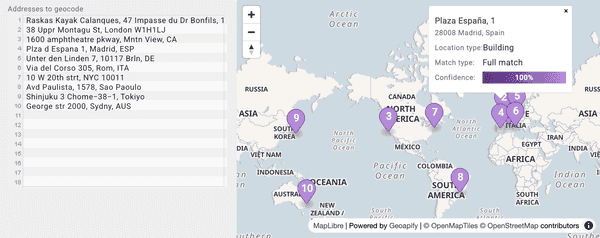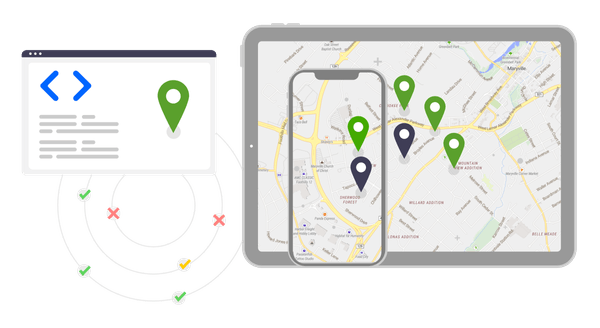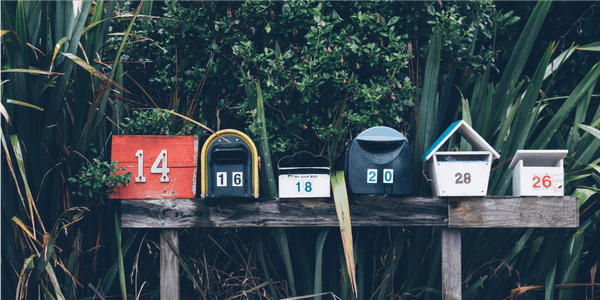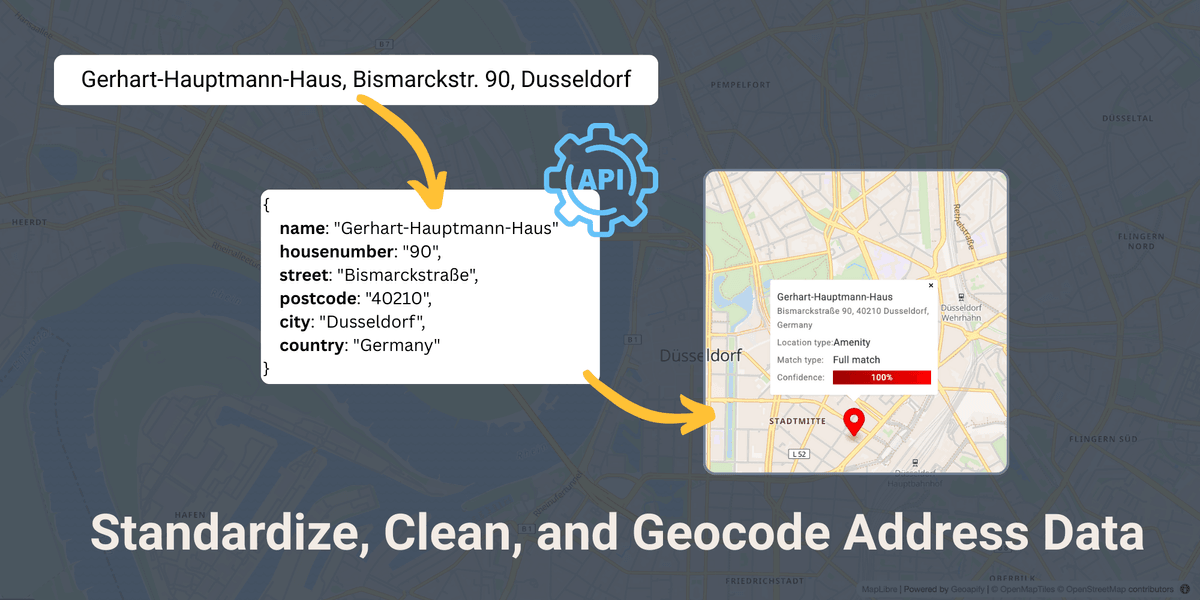On this page
Address Standardization is the process of converting messy, inconsistent, or incomplete address text into clean, structured, and consistently formatted data. For businesses in the US and EU, standardized addresses reduce failed deliveries, lower return costs, and keep customer records reliable.
The challenge comes from how people write addresses. Formats vary by country, local spellings and diacritics get lost, and abbreviations or typos create confusion. Even small mistakes can make an address unusable.
Standardization corrects errors, fills in missing parts, and structures each record into a predictable format — house number, street, city, postcode, country. The result is data you can trust and reuse across systems.
In this guide we’ll explore:
- the concept of address standardization
- practical examples
- different methods and tools
- how to implement it with Geoapify — using a no-code tool or the Geocoding API for automation at scale.
What Is Address Standardization?
Address standardization means bringing address data into a consistent and reliable format. A standardized address is one that is corrected, structured, and written according to commonly accepted rules in its country.
For example, let’s take this messy input:
“Raskas Kayak Calanques, 47 Impasse du Dr Bonfils, 13008 Marsel, FR”
After standardization, it becomes:
“Raskas Kayak Calanques, 47 Impasse du Docteur Bonfils, 13008 Marseille, France”

The standardized version corrects spelling errors (“Marsel” → “Marseille”), expands abbreviations (“Dr” → “Docteur”), and ensures all key elements are in place: house number, street, postcode, city, and country.
This consistency makes addresses easier to store, search, and use across shipping, customer management, or mapping applications.
Address Standardization Examples
Real-world addresses often contain typos, abbreviations, or inconsistent formatting. Here are some examples of how address standardization corrects and structures them:
| Input (Messy) | Standardized Result |
|---|---|
| Raskas Kayak Calanques, 47 Impasse du Dr Bonfils, 13008 Marsel, FR | Raskas Kayak Calanques, 47 Impasse du Docteur Bonfils, 13008 Marseille, France |
| 38 Uppr Montagu St, London W1H1LJ | 38 Upper Montagu Street, London, W1H 1LJ, United Kingdom |
| 1600 amphtheatre pkway, Mntn View, CA | 1600 Amphitheatre Parkway, Mountain View, CA 94043, United States |
| Plza d Espana 1, Madrid, ESP | Plaza de España 1, 28008 Madrid, Spain |
| Unter den Linden 7, 10117 Brln, DE | Unter den Linden 7, 10117 Berlin, Germany |
| Via del Corso 305, Rom, ITA | Via del Corso 305, 00186 Roma RM, Italy |
| 10 W 20th strt, NYC 10011 | 10 West 20th Street, New York, NY 10011, United States |
| Avd Paulista, 1578, Sao Paoulo | Avenida Paulista, 1578, Bela Vista, São Paulo - SP, 01310-200, Brazil |
| Shinjuku 3 Chome−38−1, Tokiyo | 3 Chome−38−1 Shinjuku, Shinjuku City, Tokyo 160-0022, Japan |
| George str 2000, Sydny, AUS | George Street, Sydney NSW 2000, Australia |
When addresses are standardized, they can also be placed accurately on a map. Here’s how the messy inputs above look after being processed with the Geoapify API and visualized as location pins:

How To Standardize Address Data: Methods and Tools
There are several ways to standardize address data. The right method depends on how many addresses you have and whether you need one-time cleanup or continuous automation.
| Method | Description | When to use |
|---|---|---|
| Manual corrections | Correcting addresses directly in spreadsheets. Simple, but slow and error-prone. | Very small datasets (dozens of records). |
| Excel or Google Sheets | Formulas and macros (e.g., =PROPER(), text splitting) can unify formatting, but can’t handle typos or international formats well. | Small datasets where some semi-automation is acceptable. |
| Address Standardization Tool | Web-based solution. Upload CSV/Excel and automatically clean up to 500 addresses for free. No coding required. | Quick corrections, one-time cleanup tasks. |
| APIs for automation | Geocoding API returns standardized addresses with confidence scores. Batch endpoint processes up to 1,000 addresses per request. | Large datasets, real-time or recurring workflows. |
With tools and APIs, address standardization becomes a repeatable, automated process that scales with your business needs.
How To Standardize Address Data with Geoapify APIs
With Geoapify you can standardize addresses in two ways:
- Geocoding API — for real-time lookups
- Batch Geocoding API — for processing up to 1,000 addresses at once, ideal for bulk cleanup
Both APIs accept a free-form address string and return a structured, standardized result.
Example: Input and Result
Input:
Via del Corso 305, Rom, ITAAPI response (simplified):
{
"results": [
{
"name": "Palazzo Doria Pamphilj",
"housenumber": "305",
"street": "Via del Corso",
"city": "Rome",
"state": "Lazio",
"postcode": "00187",
"country": "Italy",
"formatted": "Palazzo Doria Pamphilj, Via del Corso, 305, 00187 Rome RM, Italy",
"address_line1": "Palazzo Doria Pamphilj",
"address_line2": "Via del Corso, 305, 00187 Rome RM, Italy",
"category": "entertainment.museum",
"rank": {
"confidence": 0.675,
"match_type": "inner_part"
}
}
],
"query": {
"text": "Via del Corso 305, Rom, ITA",
"parsed": {
"housenumber": "305",
"street": "via del corso",
"city": "rom",
"country": "ita"
}
}
}Understanding the result
formatted→ full standardized address, ready for displayaddress_line1/address_line2→ two-line format (highlighting the main name and the full address)housenumber,street,city,postcode,state,country→ structured fields for reliable database storagecategory→ extra context when available (here: a museum)rank.confidence→ how reliable the match is (0.675 in this case = good, but not 100%)match_type→ shows how the result relates to the input. In this case,inner_partmeans the query was for an address, but the API returned an amenity (Palazzo Doria Pamphilj museum) located inside that address.query.parsed→ shows how the free-form text was interpreted (useful for debugging misspellings or incomplete input)
This makes it easy to compare what the user typed (Rom, ITA) with the clean standardized result (Rome, Italy) and decide whether the confidence is high enough to accept automatically.
Code samples
You can integrate the Geocoding API into any system or workflow. Start with these examples:
- Batch geocoding in JS with rate limits:
https://www.geoapify.com/tutorial/batch-geocoding-js-and-rate-limits/ - Geocoding in Python (step-by-step tutorial):
https://www.geoapify.com/tutorial/geocoding-python/ - Python: Address standardization samples (parse & store fields):
https://github.com/geoapify/maps-api-code-samples/tree/main/python/address-standardization - Node.js: Respect RPS limits during geocoding:
https://github.com/geoapify/maps-api-code-samples/tree/main/node/geocoding-with-RPS-limit-respect - Node.js CLI: Geocode CSV with retries (robust pipeline):
https://github.com/geoapify/maps-api-code-samples/tree/main/node/geocoding-cli-from-csv-with-retries
Conclusion
Address standardization ensures that your data is consistent, reliable, and ready for use in logistics, analytics, and customer management.
With Geoapify, you can:
- Standardize addresses interactively with the Address Standardization Tool
- Automate the process at scale with the Geocoding API or Batch Geocoding
Whether you’re cleaning up a one-time customer file or building a real-time pipeline, Geoapify provides flexible, global solutions based on open data.
Try it yourself — Sign up and get a free API key and see how standardized address data improves your workflows.
FAQ
What is the difference between address standardization and address validation?
Address standardization corrects and formats addresses into a consistent structure (street, city, postcode, country). Address validation checks whether the address actually exists in reality. Learn more in our address validation guide.
How accurate is Geoapify address standardization?
Accuracy depends on the input and open datasets. High confidence scores (0.9+) usually mean a reliable building-level result, while medium scores may still be useful at city or street level.
Can I use standardized addresses in my database or CRM?
Yes. With Geoapify’s open data policy, you can store, reuse, and share standardized addresses freely.
How can I standardize addresses in bulk?
Use the Batch Geocoding API to process up to 1,000 addresses per request. See our batch geocoding tutorial for details.
Is there a no-code way to standardize addresses?
Yes. Try the Address Standardization Tool to upload a CSV/Excel file and clean up to 500 addresses for free.
How is Geoapify different from postal services like USPS?
Geoapify is not an official postal service. Instead, it provides global coverage using open datasets like OpenStreetMap, making it more flexible and cost-effective for international businesses. See also: what is a standardized address.
Where can I find code examples?
Check our developer resources: Geocoding with Python, Node.js batch geocoding, and Python address standardization samples.
Read More
Explore more resources on working with address data:

How To Parse Postal Addresses With API, Regex, NMP or Libpostal

6 Way To Do Address Validation and Address Verification

